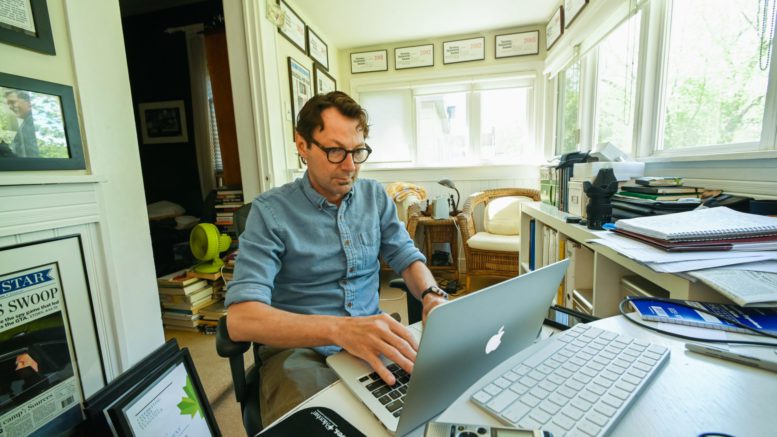As the coronavirus continues to spread, changing the world of journalism as we know it, an older pandemic — anti-Black racism — is transforming the way we do our job and cover protests.
Toronto Star senior reporter Jim Rankin dedicated most of his career covering crime and racial justice in every aspect of society, including policing. He shared his perspectives on the future of journalism and reporting in the face of COVID-19, as well as the fallout from the death of George Floyd, in a Zoom conversation with Living Room Newsroom on June 11.
“There’s a lot of unknowns,” Rankin said about being forced to work from home. “It’s brought some challenges and it has some advantages. It’s proven right off the bat that you can move a newsroom into the home right away and still be able to do everything. But collaborating and communicating is a challenge. The thing that’s missing is that you can’t walk down the hallway, bump into somebody and brainstorm,” he said.
“It’s the moments of serendipity that are kind of hard to recreate when you’re doing things virtually. So that’s missing. The virus has changed everything about how we do our jobs, and it’s a great disrupter for everybody.”
Since March 17, Toronto Star newsroom staff have been working from home. While some are enjoying it, Rankin misses going out and reporting.
“I personally want to get outside and do a lot of reporting. I want to get out of here. As things open up a bit more, I don’t want to be cooped up in here. I’m also a photographer, but they’re not using me as such right now. They’re trying to minimize our contact with anybody,” he said.

Until recently, most news stories were about the virus. Some reporters have stories sitting on their desks from two months ago because priority coverage was given to the pandemic and hard news, as opposed to feature stories. COVID-19 has profoundly changed the stories journalists are covering.
Then, the killing of George Floyd happened. The news is now split between the pandemic and coverage of Black Lives Matter protests in all 50 U.S. states and many countries worldwide.
“What is happening is raising very important questions around policing, anti-Black and anti-Indigenous racism, and it’s all not just limited to police, but to all of our systems. The virus itself is exposing disparities, like who is getting disproportionately ill with the coronavirus,” he said.
Even though following health guidelines and remaining objective is essential, Rankin is supportive of columnists and everyone speaking up about this important matter.
“The journalism that I’ve been consuming has been really top notch, especially knowing that it’s being done in the middle of a pandemic,” he said.
Rankin has spent most of his career covering racial issues, including policing, incarceration, school suspensions and expulsions by race, and racial disparities in the child protection system.
For over a decade of his career, he worked on the internationally acclaimed Toronto Star investigative series Known to Police, an analysis of Toronto’s controversial police practice called ‘carding’, in which thousands of people — mostly Black men — were stopped and questioned by police for no apparent reason.
Balancing journalistic responsibility and our strong feelings about a certain matter can be difficult, but staying objective and following health guidelines is key, according to Rankin.

“As a reporter, you’re supposed to be fair around anything you’re covering. For me personally, it’s been pretty heartening to see what’s been happening. I’ve covered racial disparities for most of my career in a number of areas, and what is happening both with the virus and the police is that it has exposed bare all the things that have been there all along,” he said.
“And it provides an opportunity for journalists to tackle those issues. Whether you’re a reporter, a columnist, or the editor at the board of a newspaper, there’s heavy work to be done and it’s being done.”
The Toronto Star newsroom is still— as most newsrooms are — predominantly white.
“As a white journalist, great conversations are happening right now in our newsroom. I’m our union representative and we’re having conversations there, too. There was a call in our newsroom for management of the company to adopt recommendations made by the Canadian Association of Black Journalists and the Canadian Association of Journalists of Colour. And the company quickly accepted every single recommendation made,” he said.
This includes improving the hiring and promoting of Black and Indigenous employees and other people of colour.
“There are improvements to be made there. Big time. We’re not any different from any of the other systems that have the systemic barriers and racism, quite frankly, that we’re seeing everywhere right now being highlighted,” he added.
“It’s moments like this where you can really push for change, and you can’t let it go be wasted. And it’s provided also opportunities for people in mainstream media, including the Toronto Star, to re-examine how we have covered some of these issues for four decades.”

